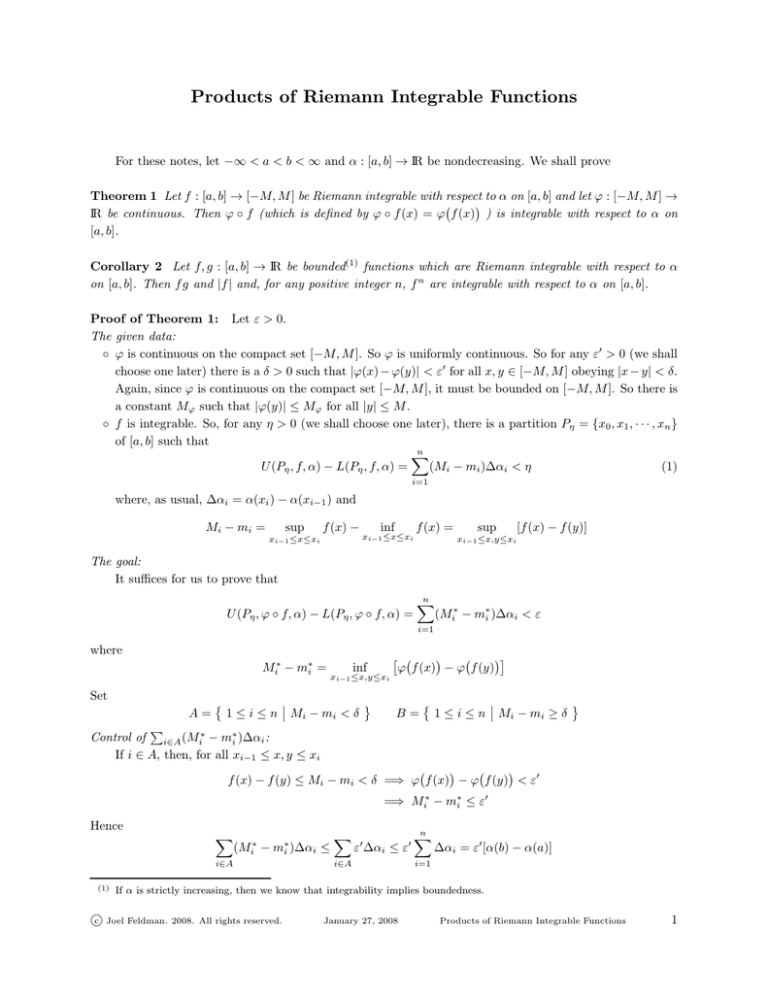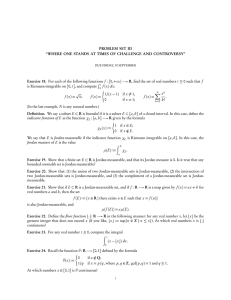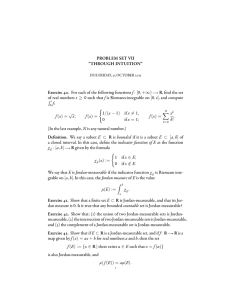Products of Riemann Integrable Functions
advertisement

Products of Riemann Integrable Functions
For these notes, let −∞ < a < b < ∞ and α : [a, b] → IR be nondecreasing. We shall prove
Theorem 1 Let f : [a, b] → [−M, M ] be Riemann integrable with respect to α on [a, b] and let ϕ : [−M, M ] →
IR be continuous. Then ϕ ◦ f (which is defined by ϕ ◦ f (x) = ϕ f (x) ) is integrable with respect to α on
[a, b].
Corollary 2 Let f, g : [a, b] → IR be bounded(1) functions which are Riemann integrable with respect to α
on [a, b]. Then f g and |f | and, for any positive integer n, f n are integrable with respect to α on [a, b].
Proof of Theorem 1: Let ε > 0.
The given data:
◦ ϕ is continuous on the compact set [−M, M ]. So ϕ is uniformly continuous. So for any ε′ > 0 (we shall
choose one later) there is a δ > 0 such that |ϕ(x) − ϕ(y)| < ε′ for all x, y ∈ [−M, M ] obeying |x − y| < δ.
Again, since ϕ is continuous on the compact set [−M, M ], it must be bounded on [−M, M ]. So there is
a constant Mϕ such that |ϕ(y)| ≤ Mϕ for all |y| ≤ M .
◦ f is integrable. So, for any η > 0 (we shall choose one later), there is a partition Pη = {x0 , x1 , · · · , xn }
of [a, b] such that
n
X
(Mi − mi )∆αi < η
(1)
U (Pη , f, α) − L(Pη , f, α) =
i=1
where, as usual, ∆αi = α(xi ) − α(xi−1 ) and
M i − mi =
sup
f (x) −
xi−1 ≤x≤xi
inf
xi−1 ≤x≤xi
f (x) =
sup
[f (x) − f (y)]
xi−1 ≤x,y≤xi
The goal:
It suffices for us to prove that
U (Pη , ϕ ◦ f, α) − L(Pη , ϕ ◦ f, α) =
n
X
(Mi∗ − m∗i )∆αi < ε
i=1
where
Mi∗ − m∗i =
inf
xi−1 ≤x,y≤xi
ϕ f (x) − ϕ f (y)
Set
A=
1 ≤ i ≤ n M i − mi < δ
B=
P
Control of i∈A (Mi∗ − m∗i )∆αi :
If i ∈ A, then, for all xi−1 ≤ x, y ≤ xi
1 ≤ i ≤ n M i − mi ≥ δ
f (x) − f (y) ≤ Mi − mi < δ =⇒ ϕ f (x) − ϕ f (y) < ε′
=⇒ Mi∗ − m∗i ≤ ε′
Hence
X
(Mi∗ − m∗i )∆αi ≤
i∈A
(1)
X
ε′ ∆αi ≤ ε′
i∈A
n
X
∆αi = ε′ [α(b) − α(a)]
i=1
If α is strictly increasing, then we know that integrability implies boundedness.
c Joel Feldman.
2008. All rights reserved.
January 27, 2008
Products of Riemann Integrable Functions
1
P
Control of i∈B (Mi∗ − m∗i )∆αi :
If i ∈ B, we cannot conclude that Mi∗ − m∗i is small. About the best we can do is
xi−1 ≤ x, y ≤ xi =⇒ ϕ f (x) − ϕ f (y) ≤ 2Mϕ =⇒ Mi∗ − m∗i ≤ 2Mϕ
On the other hand, we can show that
η>
n
X
P
i∈B
(Mi − mi )∆αi ≥
i=1
∆αi must be very small, because, by (1),
X
(Mi − mi )∆αi ≥
i∈B
X
δ∆αi =⇒
i∈B
X
∆αi <
η
δ
i∈B
Hence
X
(Mi∗ − m∗i )∆αi ≤
i∈B
X
2Mϕ∆αi < 2Mϕ ηδ
i∈B
The end game:
U (Pη , ϕ◦f, α)−L(Pη , ϕ◦ f, α) =
X
(Mi∗ −m∗i )∆αi +
i∈A
′
X
(Mi∗ −m∗i )∆αi
i∈B
< ε [α(b) − α(a)] + 2Mϕ ηδ
It now suffices to choose
ε′ =
ε
2[α(b)−α(a)]
η=
εδ
4Mϕ
Proof of Corollary 2: The integrability of |f | and f n both follow directly from Theorem 1, with ϕ(y) = |y|
and ϕ(y) = y n , respectively. If f and g are bounded and integrable, then so is f + g. Hence, by Theorem 1,
with ϕ(y) = y 2 , we have that f 2 , g 2 and (f + g)2 = f 2 + g 2 + 2f g are all integrable. The integrability of
f g = 21 (f + g)2 − f 2 − g 2 now follows by linearity.
c Joel Feldman.
2008. All rights reserved.
January 27, 2008
Products of Riemann Integrable Functions
2





